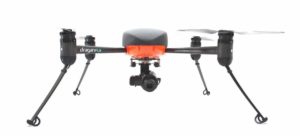
Ray Kurzweil has always been out there. Way out there... But then that’s the nature of the gig. He’s noted as an inventor and futurist and has made some stunning, if not entirely accurate, predictions over the decades.[1] One of his more interesting propositions has to do with the makeup of the universe.
Kurzweil sees it not as comprising of matter, nor of energy, but rather he holds that the universe is made of data. The universe is data. Hold onto that for a while…
It’s an idea that, as an investor, really appeals to me. Which is why I often choose to study ventures through the Kurzweil lens.
That perspective is becoming more fascinating all the time with the advent of artificial intelligence (AI) and high-speed 5G communication technology. It’s happening now, it’s happening fast, and it’s having a massive impact on businesses and investment.
Newsflash: The corporate world is frantically reorganizing operations to keep up, or face fierce competitive pressure from disruptive players within their respective sectors.

Consider Tesla (NASDAQ: TSLA)—a decade ago it was a home for dreamers with a business model that, as far as the mainstream could see, amounted to a waste of time and money.
Today, it’s the most valuable property in the automotive world, valued at more than $200 billion and topping the combined value of rivals such as Fiat Chrysler (NYSE: FCAU) - $20 billion, Ford (NYSE: F) - $24 billion, Ferrari (NYSE: RACE) - $32 billion, General Motors (NYSE: GM) - $36 billion, BMW (OTC US: BMWYY) - $41 billion, Honda (NYSE: HMC) - $46 billion and Volkswagen (XETRA: VOW3.DE / OTC US: VWAGY) - $74 billion.[2] Once only an investment for dreamers, it’s now become a home run for savvy investors who got in early.
Incredibly, Tesla isn’t even a car company. It’s a tech firm. Now that’s what I call disruption. One reason behind its success—owners love the Tesla concept of the connected car. Software updates are downloaded to your vehicle over WiFi, adding new features, more power, updated navigation data sourced from Google… It’s about data, my friends. Data!
Even the company’s retail model is centered around data. As you undoubtedly know, the whole thing is done online, including sales and after-sales support and service.
It’s fair to say Tesla has rocked the established automotive world. Traditional automakers may never catch up… ok, big statement. Let me rephrase this… automakers are now attempting to catch-up, but today, they remain behind.
Fear of this kind of Tesla-like disruption has spread to virtually every sector.
A recent report by New Vantage Partners (NVP) describes the near panic situation in some of the world’s largest corporations. Firms such as Allstate (NYSE: ALL), Morgan Stanley (NYSE: MS), Astra Zeneca (NYSE: AZN), Johnson & Johnson (NYSE: JNJ), General Motors (NYSE: GM), and Bloomberg (private), just to name a few, are at warp speed on establishing artificial intelligence and big data competencies within their organizations.[3]
Of the companies covered in NVP’s study, market leaders are accelerating the pace of their big data and AI investments—with three-quarters citing fear of disruption from data-driven digital competitors; nine out of ten saying investment is required to transform into agile and competitive businesses; and nearly the same number officially expressing urgency to invest.
Yet many are still struggling with how to compete on data and analytics. A large part of the reason is cultural rigidity—a palsy that can prove fatal when nimbler, new competitors burst onto the scene.
Critically, the report states that most companies are still not data-driven, and won’t be anytime soon. NVP concludes that business adoption of big data and AI initiatives must be viewed through a long-term lens—as a process and a journey. Only 31.0 percent of companies say they are data-driven. This number has actually declined from 37.1 percent in 2017 and 32.4 percent in 2018.
Clearly, this is the wrong direction. Firms need to adopt a long-term approach, focusing on the complex cultural challenges as a starting point.
And therein lies a problem, because for a long time business has tended to approach things on a quarter-to-quarter basis.

This approach, known as “short-termism,” creates an excessive focus on short-term results at the expense of long-term interest.[4] Short-term performance pressures from investors can result in an extreme emphasis on quarterly earnings, with less attention paid to strategy, fundamentals, and long-term value creation.
Corporations too often respond to these pressures by reducing their expenditures on research and development and/or foregoing investment opportunities with positive long-term potential.
While there is a significant record of discussion on the harms of short-termism, I would argue that failure to understand your business from a data perspective now, more than ever, can be fatal.
My favorite example of this is the early pioneer of smart phones, Research in Motion (NYSE: BB / TSX: BB).
Once the golden apple of the collective investor eye, Research in Motion (RIM) had one of their BlackBerrys in what seemed like every pocket on the street. People were hooked, even birthing the term “CrackBerry.” This led to many developing odd thumb twitches that would take years to go away. The eventual withdrawal from a physical keyboard was long, painful, and loud.

Yet, ultimately, RIM crashed and burned, taking down billions in investment value and leaving throngs of heartbroken users looking begrudgingly at Apple’s iPhones or other, similarly argumentatively inferior products.
The trouble with RIM, Steve Jobs said, was that they were a hardware company competing in a software game.[5] I’d agree to a point, but I’d take this argument a step further.
RIM failed to understand their business from a data perspective. What RIM did really, really well, and the reason they were so popular, is that they connected people, mainly business people, through a free, secure, instant messaging facility. Essentially, they connected people, and that was the essence of their business.
Ultimately, it made no difference which flavor of fruit you preferred, or whether or not you were hooked on a physical keyboard. The hardware was only a tool for sharing data.
I’d argue that if RIM had understood that they were in the connection and data sharing business, they’d possibly have gone in a different direction and leveraged their considerable and loyal user base into new paradigms and turned all of the data they generated into gold.
In any case, RIM got sucked down the black hole of destiny, an ignominious fate to be sure, and hopefully a lesson for others to learn from. Read my lips: the ultimate product born is the data.
While you can easily identify investment targets in the data-driven space, many of them are priced beyond the point at which an average investor can get much leverage. Tesla (NASDAQ: TSLA) at $1,600 plus per share or Google (NASDAQ: GOOGL) at a similar lofty price, while both data-driven plays, don’t offer the same kind of upside found in microcaps.
If you’re like me, you probably want some of that high-gain, microcap growth potential in a balanced portfolio.
I recently had an opportunity to talk with Cameron Chell, now incarnate as the Chairman & CEO of Draganfly Inc. (OTCQB: DFLYF / CSE: DFLY / FSE: 3U8), an innovator in aerial robotics.[6] Mr. Chell gets the fact that DFLY is not merely in the drone and robotics business—they’re actually in the data business.
You may have already read my initial article on DFLY, but if not, then make sure you check it out here.
Chell’s vision for the company finds its footing in the fact that drones collect and provide more data than any other source other than smart phones. I know from talking with him back in November, and again last month, that Chell understands that while the immense opportunity Draganfly is looking at in the drone space today is substantial, it is the data and intelligence the company can provide that is the real upside and value proposition well into the future.[7]

Just to provide some background, Draganfly has been a leader in the unmanned aerial vehicle (UAV) industry for more than two decades, supporting clients with enterprise drone solutions, purposed military solutions, contract engineering services, custom software, and professional UAV applications to solve even the most difficult problems.
In fact, from a technology standpoint, Draganfly invented the first quadcopter drone over 20 years ago.
Among other noteworthy accomplishments, the company was the first ever to save a human life using a drone, which earned it a place in the Smithsonian's National Air and Space Museum.[8]
The recent push by the US Federal Government to get Chinese-made drones out of the US due to spying concerns has opened up a massive hole in the market, a vacuum Draganfly is busy filling. I don’t have the space here to recap all of the most recent moves the company has made, so I urge you to visit their website. [9] [10]
I want to bring your attention, however, to one piece of news in particular.
Draganfly has begun working with Hollywood film production company Enderby Entertainment to market a new safety solution to monitor for possible COVID-19 symptoms on TV and film sets.
Draganfly will provide its Safe Set Solutions, a ground-based technology that uses symptom pre-screening including elevated body temperature, heart rate, coughing, sneezing and social distancing measurements relayed onto digital displays to help ensure that everybody on the set is safe.[11]

I mention this because this technology can be employed in broader use cases—public safety, for example.
Fixed location or flying COVID-19 sensors strategically located within a city or state can identify factors such as social distancing and elevated body temperature, and use that data to predict where outbreaks of COVID-19 will likely occur and in what timeframe.
This is actionable intelligence in a very rudimentary form, yet incredibly valuable with the potential to save lives and help communities get back to some level of normalcy. We really do need to support and adopt technology to help us get the economy going again. For me… this is a no-brainer.
Public safety agencies already use predictive analytics to target response and allocate resources, but the approach is based on historical data. Imagine what will happen as 5G adoption spreads and agencies can use real-time, rich data feeds.
Pandemic response intelligence is just the tip of the iceberg. Public safety, crime prevention, border security, traffic management, and scores of industrial use cases, just to name a few, all come to mind.
Draganfly today reminds me of Apple (NASDAQ: AAPL) back in the early 1980s. Steve Jobs made the decision to control the Apple environment end-to-end by integrating hardware and software as one package. Apple computers would only run Apple’s operating system (OS), and applications had to be written specifically for Apple’s OS and meet Apple’s standards.
As a result, Apple was able to deliver market-leading innovations year-on-year, and a user experience far more enriching than that found in the Wintel (Microsoft Windows and Intel) environment.
Draganfly’s approach is almost identical. The company draws on its deep internal tech and engineering bench to create innovative patented solutions without having to go out to third-party suppliers for critical technology and support—just like Apple!
What Apple delivered ultimately was not hardware, nor software, but rather an insanely great user experience. It was never about the technology, really. It was about what people could do with it. In essence, intelligence and dare I say once again… data!
Which is one of the things I really like about Cameron Chell. He sees past the technology to identify what really matters—the data Draganfly technology can bring through its software, drones and robotics divisions, and above all else, the opportunity to provide actionable intelligence based on the company’s hardware platform to clients across a broad range of sectors.
The potential range and volume of intelligence is defined by the simple fact that, next to cell phones, no device collects more data than drones.
Draganfly is especially interesting as an investment target not only because at current price levels an average investor can get good leverage, but because Chell gets the data vision.
The company with its hardware solutions, in today’s current climate of fear and loathing of all things Chinese, has really great “now appeal,” as they fill the void left by the former market leaders when the US government suspended use of Chinese-made technology, and more specifically, the specialized US government use of secure drones.
If Chell and Draganfly can deliver on that immediate opportunity and succeed in realizing the company’s long-term vision, and I think there’s a reasonable probability that they will, DFLY could provide the kind of returns to investors so characteristic of disruptors.

Blake Desaulniers, Contributor
for Investors News Service
P.S. To discover more opportunities in the hottest sectors in North America, sign up now to the Financial News Now newsletter to get the latest updates and investment ideas directly in your inbox!
DISCLOSURE: Draganfly Inc. is a Blake Desaulniers portfolio holding.
DISCLAIMER: Investing in any securities is highly speculative. Please be sure to always do your own due diligence before making any investment decisions. Read our full disclaimer here.
[1] https://www.ted.com/speakers/ray_kurzweil
[2] https://www.forbes.com/sites/sergeiklebnikov/2020/07/01/tesla-is-now-the-worlds-most-valuable-car-company-with-a-valuation-of-208-billion/#713817853347
[3] http://newvantage.com/wp-content/uploads/2018/12/Big-Data-Executive-Survey-2019-Findings-122718.pdf
[4] https://www.cfainstitute.org/en/advocacy/issues/short-termism
[5] https://globalnews.ca/news/384832/rims-rise-and-fall-a-short-history-of-research-in-motion/
[6] https://www.bloomberg.com/profile/person/1799633
[7] https://draganfly.com/about-us/
[8] https://www.si.edu/object/drone-quadrotor-draganflyer-x4-es:nasm_A20160076000
[9] https://www.digitaltrends.com/cool-tech/us-interior-department-grounds-800-strong-drone-fleet-over-security-fears/
[10] https://edition.cnn.com/2019/05/20/politics/dhs-chinese-drone-warning/index.html
[11] https://www.urbanairmobilitynews.com/uncategorized/draganfly-drones-partner-with-enderby-entertainment-to-re-open-hollywood/